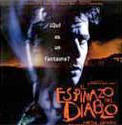Film Review: The Devil's Backbone
A Spanish Horror movie with a difference...
It could be the reaction of irony-jaded audiences, too long exposed to self-referential, post-modern horrors such as the Scream trilogy or effects-heavy cop-outs such as Jeepers Creepers. Whatever the catalyst, there is now a popular trend in modern cinema that highlights visual and sonic eeriness, heightens tension through what is left unseen and displays both a dread as well as respect towards the dead and dying. The Spanish film 'The Devil's Backbone' comfortably fits into this emerging trend in horror cinema.
 In its opening scenes The Devils Backbone (written and directed by Guillermo
del Toro) features the violent death of a young boy which sets the tone of a
film that tries to answer the question ?what is a ghost?? In the past few years, however, there has been a glut of films that exploit
this primal human fear, including The Sixth Sense,
and most recently and successfully, The Others. Comparisons between The Devil's
Backbone and the the latter are unavoidable. Both show children accepting and
adapting to the supernatural, in contrast to the hostile disbelief or terror
exhibited by grown-ups. The juxtaposition of these two attitudes serves to
emphasise the chasm that exists between the experiences of children and adults,
giving the audience a sense of the child's isolation and helplessness.
In its opening scenes The Devils Backbone (written and directed by Guillermo
del Toro) features the violent death of a young boy which sets the tone of a
film that tries to answer the question ?what is a ghost?? In the past few years, however, there has been a glut of films that exploit
this primal human fear, including The Sixth Sense,
and most recently and successfully, The Others. Comparisons between The Devil's
Backbone and the the latter are unavoidable. Both show children accepting and
adapting to the supernatural, in contrast to the hostile disbelief or terror
exhibited by grown-ups. The juxtaposition of these two attitudes serves to
emphasise the chasm that exists between the experiences of children and adults,
giving the audience a sense of the child's isolation and helplessness.
Another similarity is that both films are set against a backdrop of war and its effects and aftermath. The Spanish Civil War impinges forcefully on the plot of The Devil's Backbone. Carlos, a ten-year-old war orphan, who enters a remote institution run by Republicans for abandoned or orphaned boys. It is run with kindly matriarchal authority by the elegant, elderly widow, Carmel, and also serves as a hiding place for gold bars intended for use by those fighting for the Republican cause. Carmel is assisted by Dr Caesare - a sympathetic, clever man - as well as a maid Conchita and her lover, the handyman Jacinto. These are the only other adults present.
Upon entering the institution Carlos immediately witnesses the ghostly apparition of a young boy, identified by the other inmates as ?the one who sighs?. Carlos senses correctly this unhappy spirit is trying to communicate something and as his curiosity and pity rise above his terror, he is told of the secret of the boy's death and of his desire for revenge. The ghost's appearance is both frightening and heart-rending but it is rather the overall atmosphere of the film, the use of breathy, echoing sound along with a sense of panic and impending disaster that give the film such a gripping pace and atmosphere. It works well enough that there is no need for the somewhat tricky twists used by The Others and The Sixth Sense.
The sadness and desperation of the murdered boy is set against the futility
and horror of war, as represented by the facist troops closing in and killing of
Republicans. These two strands of
horror: personal tragedy and the widespread insanity that grips a population at
war, combine to make an extremely effective and moving film, one which prompts the
audience to ask themselves what they, in fact, find more terrifying: a dead
child attempting to reach those still alive or the living whose humanity and
moral centre seems to have already died.
Niamh O
